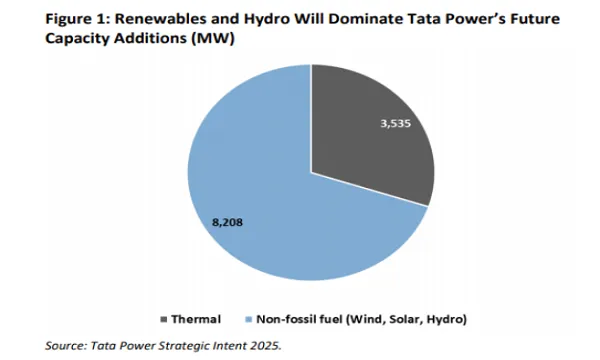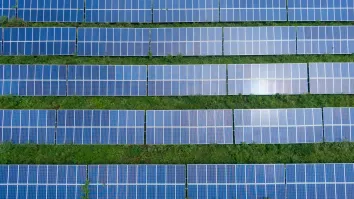
Tata Power to raise renewables' share in new capacity additions to 70%
13GW coal-fired power projects have been cancelled or shelved since 2010.
Renewables and hydro are expected to dominate India’s largest private integrated power company Tata Power’s future capacity additions, as it has made it publicly clear that it will cease building new coal-fired capacity, according to a report released by the Institute for Energy Economics and Financial Analysis (IEEFA).
The report, which highlights the company’s long-term strategy that will see renewable energy dominate its power capacity build-out going forward, highlighted that Tata Power is leading the country’s renewable energy transition following its withdrawal from building new coal-fired power plants.
According to the report’s co-author, IEEFA’s energy finance analyst Simon Nicholas, Tata Power’s focus on renewables makes sense given the major energy transformation occurring in recent months.
“The company’s plan, Strategic Intent 2025, calls for up to 70% of new capacity additions to come from solar, wind and hydro through to 2025,” Nicholas said in a statement. “This represents a significant departure from the accepted wisdom of just a few years ago that a major expansion of coal-fired power would be required to serve India’s growing electricity demand.”
The majority of Tata Power’s thermal capacity is reportedly centred on its Mundra coal-fired power plant, which experienced losses reaching $191m for the first three quarters of FY 2018-2019. Whilst a bailout of the Mundra plant, which is recording consistent, significant losses, is being planner to increase the tariff burden on consumers and realise a debt write-down for bank lenders, Tata Power has stated it will only halve the losses at Mundra, Nicholas revealed.
Prior to the commissioning of the Mundra power plant and subsequent heavy financial losses, Tata Power had reportedly been planning other new coal-fired power plants, including some to be fuelled by imported coal.
In March 2019, a National Green Tribunal panel was set up to investigate the environmental impact of Tata Power’s proposal to convert unit 6 (500 MW) of its Trombay Thermal Power Plant from oil to imported coal. The conversion received initial environmental approval in 2014.
However, with the imported coal-fired Mundra plant in deep financial strife and no apparent progress on the Trombay conversion since then, the Global Coal Plant Tracker database reportedly considers this project to have been shelved.
IEEFA’s report highlighted that this is far from the only Tata Power coal-fired power proposal to have been shelved this decade. Since 2010, another 13GW of such projects have been cancelled or shelved, which is twice the current coal-fired power capacity of the company.

Amongst the projects to have been cancelled or shelved are units 6 and 7 of the Mundra plant (1,660MW), whilst another proposal to be fuelled by imported coal, the 2,400 MW Coastal Maharashtra Project, was halted in 2012 due to a rise in imported coal cost. Another imported coal project – the 2,000 MW Tata Begunia proposal was reported to be cancelled as recently as January 2017.
Tim Buckley, IEEFA’s director of energy finance studies and co-author of the report, further noted that Tata Power’s shift mirrors the transition underway within the Indian power sector as a whole, driven by least cost renewable energy.
“The shift away from new coal-fired power is moving faster than anyone had predicted,” Buckley explained. “The current Indian fiscal year has seen net coal-fired power additions come close to ceasing altogether.”
Peak coal-fired power capacity in India is on the horizon, and growing electricity demand will be served by current coal power capacity and rapidly growing renewable energy capacity, according to the IEEFA analysts.
India has helped drive its energy transition with ambitious renewable energy installation targets including an aim to reach 275GW of renewable capacity by 2027. Over the same period, net coal-fired power additions are planned to slow significantly.
With more than 40GW of existing coal-fired power plants under financial stress in India, Tata Power is seeking to only add new coal-fired power capacity via fire-sale acquisition, at 30%-40% of historical investment, the report highlighted.
“Tata Power’s renewables operations are profitable, recording earnings before interest, depreciation and amortisation (EBITDA) of $249m in FY 2017-18, and an EBITDA margin of 89%,” IEEFA said, adding that the company is also leading India in rooftop solar, electric vehicle charging, and via its recent installation of India’s first grid-scale battery storage system alongside Mitsubishi Corporation and AES India
As it stands, Tata Power’s generation capacity is dominated by thermal (mostly coal-fired) power – the majority of which is financially unviable. Thermal power capacity at present makes up 70% of total generation.

However, Tata Power will need to increase its renewables installation rate significantly if it is to meet its Strategic Intent target of reaching up to 11.3GW of non-fossil fuel power capacity by 2025.
“Leading utilities like Tata Power are assisting to make the energy transition in India’s power system a reality,” says Nicholas. “Although the company is not alone in doing so, it is one of the best examples of that transformation in action.”



















 Advertise
Advertise






